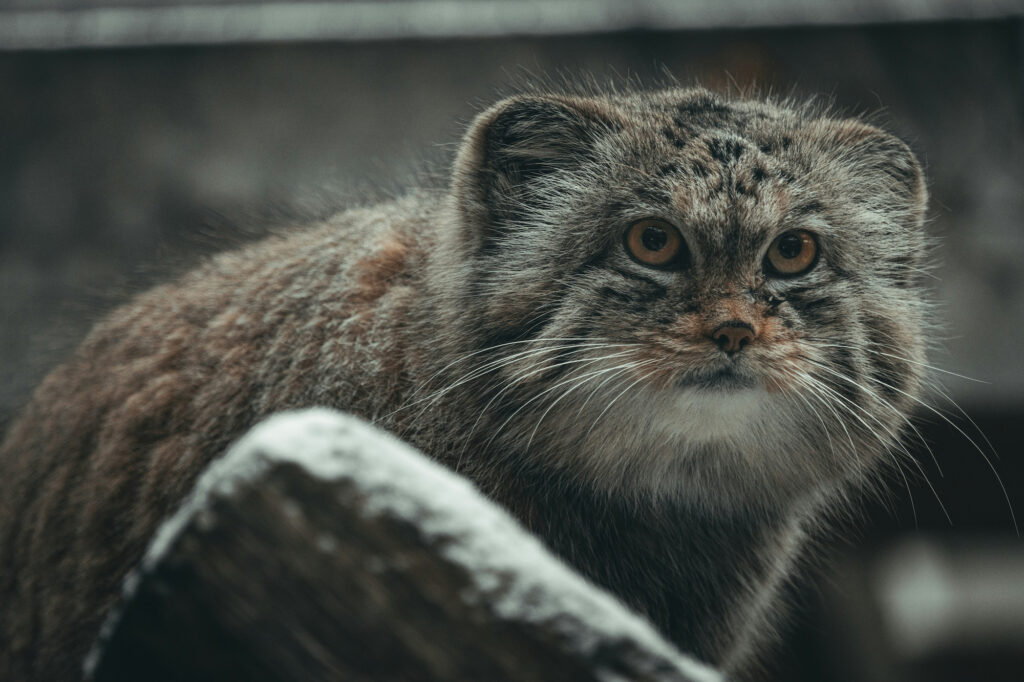Introduction: Mongolia’s Wild Spirit and the Secretive Manul
Mongolia is a land like no other—a sweeping expanse where the horizon seems infinite, the sky a vast dome of brilliant blue, and nature exists largely untouched by human hands. For centuries, this country has captured the imagination of travelers, scientists, and adventurers. From the snow-capped Altai Mountains in the west to the red sands of the Gobi Desert in the south, Mongolia is a canvas of ecological diversity. Its rivers, grasslands, rocky outcrops, and deserts are home to a remarkable array of wildlife, including the elusive snow leopard, the majestic argali sheep, and the hardy wild horses known as Przewalski’s horses.
Among all these remarkable creatures, one species stands out for its beauty, mystique, and almost mythical elusiveness: the Manul, also known as the Pallas’s cat. While not as large or fierce as the snow leopard, the Manul is arguably just as captivating. With its dense, silvery-gray fur, wide-set eyes, flattened face, and stocky body, it appears almost prehistoric, a living relic from an ancient age. Unlike tigers or leopards, which may be spotted in documentaries or wildlife films, the Manul remains largely hidden from human eyes. It inhabits some of Mongolia’s most remote regions, favoring rocky steppes, alpine valleys, and high desert terrains.
For wildlife enthusiasts, photographers, and adventure travelers, encountering a Manul in the wild is a rare and unforgettable experience. This journey, however, requires planning, patience, and often the guidance of experts. That’s where Explorer.Company comes in, Mongolia’s leading specialist in adventure travel. Combining local knowledge with deep expertise in wildlife behavior, Explorer.Company crafts guided expeditions and photography-focused tours specifically designed to increase the chances of observing this remarkable cat. Meanwhile, leading 4×4 Mongolia car rental provider AVIS provides the perfect vehicle solution for reaching these remote regions, offering specially equipped Toyota Land Cruisers capable of navigating Mongolia’s challenging terrain safely and comfortably.
This comprehensive guide will introduce you to the Manul, explore its behavior, habitat, and conservation, and provide practical tips for planning your own adventure to see this extraordinary wild cat. Whether you are a wildlife photographer, nature lover, or intrepid traveler, this guide will serve as your ultimate resource for the Manul in Mongolia.
What is a Manul?
The Manul (Otocolobus manul) is a small wild cat native to the grasslands, rocky outcrops, and semi-deserts of Central Asia. While it resembles a domestic cat at first glance, the Manul is a distinct species, adapted over millions of years to survive in some of the harshest climates on Earth. Its name, “Otocolobus,” refers to its unusual ear structure—low-set and rounded—which enhances its stealth in hunting and allows it to remain inconspicuous in rocky terrain.
Physical Characteristics
- Size: Adult Manuls typically weigh between 2.5 and 5 kilograms (5.5–11 pounds) and measure 46–65 centimeters (18–26 inches) in body length, with a tail that adds an additional 21–31 centimeters (8–12 inches). Though roughly the size of a domestic cat, its stocky build and thick fur make it appear larger.
- Fur: One of the Manul’s most striking features is its dense fur, which is among the thickest of any wild cat. In winter, each square centimeter of its coat can contain over 7,000 hairs, providing essential insulation against temperatures that can plunge below –40°C in Mongolia’s winter months. In summer, the fur becomes shorter and more mottled, allowing it to blend seamlessly with the dry grasslands and rocky landscapes.
- Color: Winter coats are silvery-gray with faint banding, while summer coats range from light brown to sandy with subtle spotting. This natural camouflage is crucial for both predator avoidance and hunting.
- Face: The Manul’s flattened face, wide-set amber eyes, and rounded ears give it a unique appearance, sometimes described as “grumpy” or “prehistoric.” These features, combined with its small stature, make it instantly recognizable to those who spot it in the wild.
- Tail: The bushy tail, adorned with dark rings, is often used as a warm wrap during rest periods. Its size also helps balance the cat while navigating rocky terrain.
Evolutionary History
Genetic studies indicate that the Manul diverged from other small cats approximately two million years ago, during the Pleistocene epoch. Unlike modern domestic cats, adapted for diverse environments and close human association, the Manul evolved as a specialist predator in open, high-altitude, and semi-arid environments. Its unique adaptations, including low-set ears, stocky build, and thick coat, were responses to Mongolia’s extreme climate, scarce prey, and rocky terrain.
The Manul’s evolutionary journey has resulted in a species that is exceptionally adapted to its environment but highly vulnerable to habitat loss, climate change, and human interference. Understanding its evolutionary context provides insight into why this cat behaves so differently from domestic cats or even other small wild cats like the lynx.
Manul vs. Domestic Cat
Despite superficial similarities to domestic cats, the Manul is a species in its own right, with distinct genetics, behavior, and ecological adaptations.
- Ancestry: Domestic cats (Felis catus) descend from the African wildcat (Felis lybica), whereas the Manul belongs to a separate genus, Otocolobus. This divergence explains many of its unique physical and behavioral traits.
- Behavior: Unlike domestic cats, which thrive near humans, the Manul is strictly solitary and avoids human contact whenever possible. Its territorial range can extend several kilometers, and it rarely ventures into populated areas.
- Physical Differences: The Manul’s legs are shorter and stockier, adapted for stability in rocky terrain rather than climbing trees. Its round pupils remain circular even in bright light, unlike the vertical slits seen in most small cats.
- Diet and Hunting: Domestic cats are opportunistic feeders, often eating a wide variety of prey and even processed foods. Manuls, by contrast, are highly specialized hunters, focusing on small mammals such as pikas, voles, and occasionally ground birds. Their hunting strategy relies on stealth and ambush rather than speed or pursuit.
For travelers, this distinction highlights the uniqueness of the Manul: it is not a “wild house cat,” but a species perfectly adapted to survive in one of the world’s most unforgiving environments.
The Life and Behavior of the Manul
Understanding the Manul’s behavior is essential for anyone hoping to encounter this elusive cat in the wild. Its habits, daily cycles, and adaptations make it both fascinating and challenging to observe.
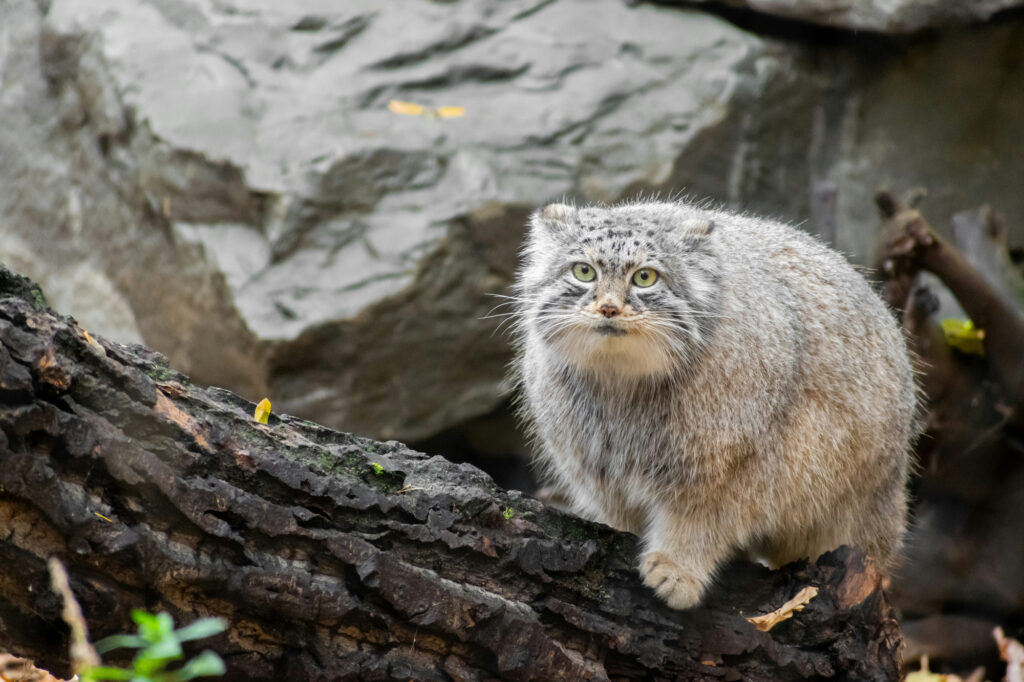
Daily Activity
- Crepuscular Habits: Manuls are most active during dawn and dusk, a behavior known as crepuscular activity. During these times, their prey—primarily pikas and small rodents—also emerge from their burrows, making hunting more efficient.
- Daytime Behavior: During daylight, Manuls often retreat into rocky crevices, abandoned marmot burrows, or dense vegetation to avoid predators such as foxes and eagles. They may spend several hours resting or grooming, conserving energy for evening hunts.
- Nighttime: While not strictly nocturnal, Manuls occasionally hunt at night, particularly in areas where human disturbance or competition from other predators is minimal.
Seasonal Behavior
- Spring: After harsh winter months, Manuls become more active. Spring is breeding season, and male cats may increase their range slightly in search of mates. Prey becomes more abundant, allowing the Manul to replenish energy reserves.
- Summer: With longer days, Manuls adjust activity to avoid heat, often hunting in early mornings and late evenings. Their summer coat allows them to remain camouflaged amidst dry grasses and rocks.
- Autumn: As winter approaches, Manuls intensify hunting activity to build fat reserves. They also begin establishing winter dens and shelters.
- Winter: Activity declines, with Manuls spending more time in sheltered locations to conserve warmth and energy. Their thick winter coat provides insulation, but harsh weather limits prey availability, making hunting more challenging.
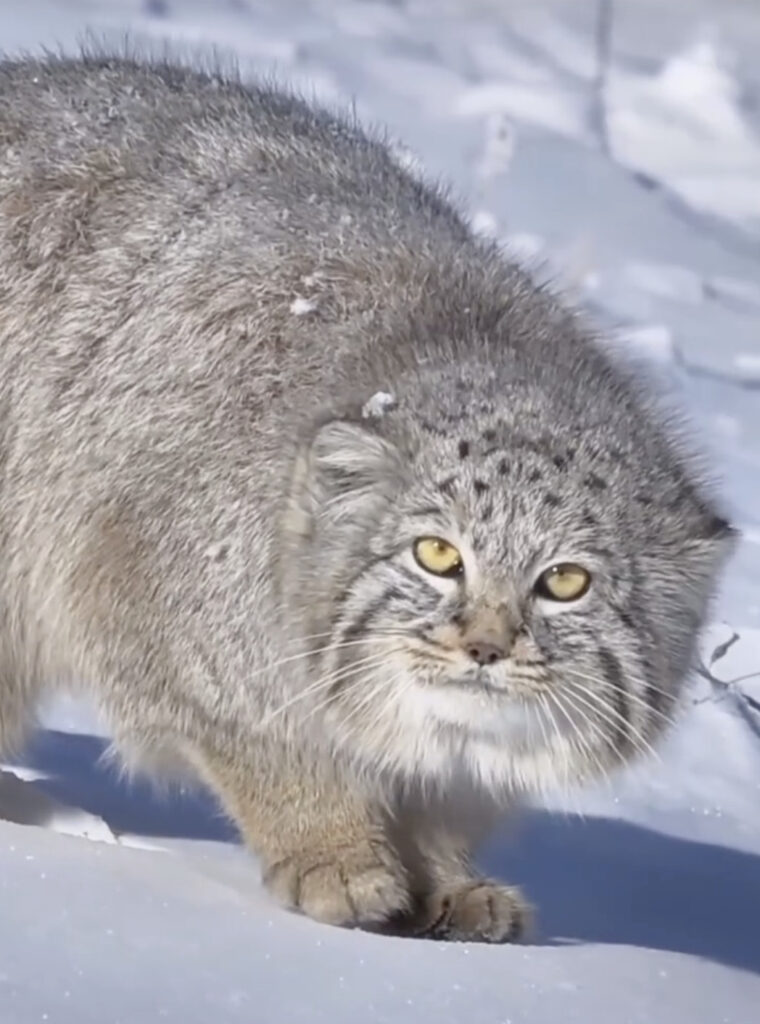
Hunting and Diet
The Manul is a highly specialized predator with a diet that varies depending on location, season, and prey availability:
- Primary Prey: Pikas (Ochotona spp.), voles, gerbils, and small birds.
- Hunting Strategy: Slow, deliberate stalking followed by a short pounce. Unlike cats that rely on speed, the Manul’s hunting method relies on stealth, camouflage, and precision.
- Prey Adaptations: Manuls are capable of hunting on uneven terrain, including rocky slopes and burrow entrances, using their short legs and low profile to remain undetected.
- Energy Conservation: Their low metabolism allows them to survive on fewer kills than larger predators, a crucial adaptation in the resource-sparse steppes and deserts of Mongolia.
Reproduction and Family Life
- Breeding Season: February to March.
- Gestation: 66–75 days, with kittens born in late spring.
- Litter Size: Typically 2–6 kittens.
- Kitten Development: Kittens remain in dens for several weeks, completely dependent on the mother. They gradually learn to hunt, using play to develop stalking and pouncing skills. By late summer, they begin independent life.
- Social Structure: Solitary, except for mother-kitten interactions. Adult Manuls rarely interact, except during mating.
Adaptations for Survival
- Camouflage: Seasonal coat color shifts blend perfectly with local vegetation and rocks.
- Temperature Regulation: Dense fur insulates against extreme cold; bushy tail provides additional warmth.
- Hunting Adaptations: Low body profile and short legs enable silent stalking.
- Territoriality: Manuls mark and defend territories using scent glands and feces, ensuring spacing between individuals and reducing competition for prey.
Where to See the Manul and Expedition Planning
Where to See the Manul in Mongolia
Mongolia’s vast landscapes provide a mosaic of habitats suitable for the Manul, from high-altitude mountains to arid deserts. While sightings can never be guaranteed due to the cat’s elusive nature, understanding the geography, altitude, and seasonal patterns greatly increases your chances.
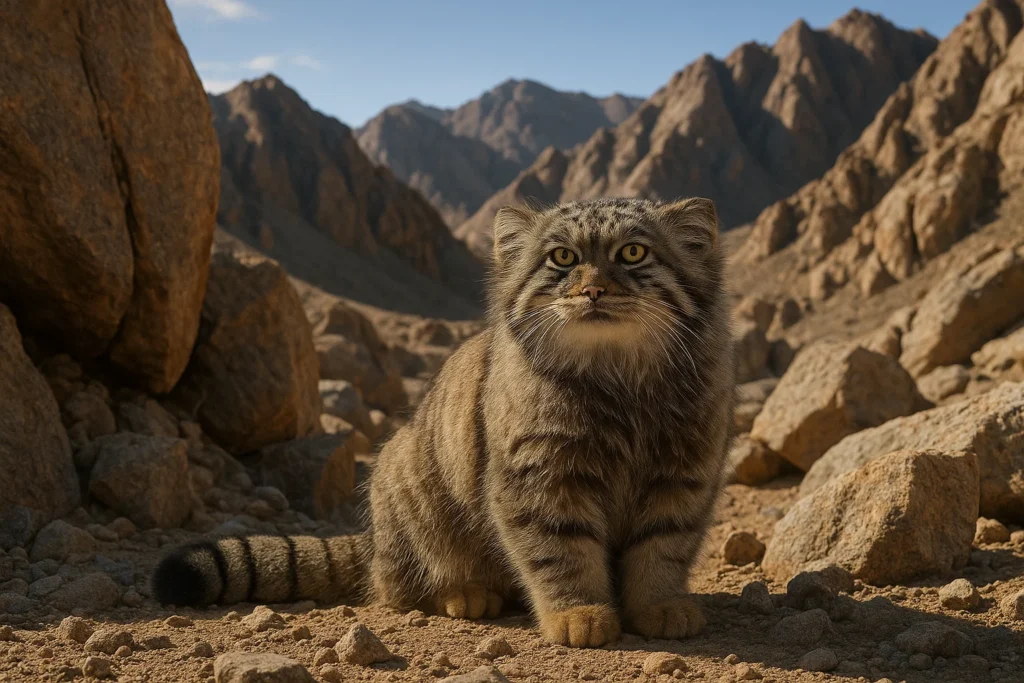
1. Altai Mountains (Bayan-Ölgii & Khovd Provinces)
- Habitat: Rocky slopes, alpine valleys, and interspersed grasslands.
- Altitude: 2,000–4,500 meters above sea level.
- Prey availability: Pikas, voles, and small birds are abundant in spring and summer.
- Accessibility: Flights to Ölgii followed by 4×4 travel with AVIS Mongolia vehicles. Roads are rugged, often requiring multiple days of off-road driving.
- Tour Highlights: Combine Manul tracking with eagle hunter experiences, hiking, and cultural immersion with Kazakh nomadic communities.
The Altai region is particularly favorable for early morning or late afternoon sightings because Manuls often sun themselves on rocky ridges during these hours. Explorer.Company guides use local knowledge and camera traps to determine the best locations to wait for sightings.
2. Khovd Province
- Habitat: Semi-desert steppes with rocky outcrops and valleys.
- Altitude: 1,500–3,000 meters.
- Notes: The area supports one of the most stable Manul populations in western Mongolia.
- Access: Roughly 10–12 hours by 4×4 from Ulaanbaatar. AVIS Mongolia vehicles are recommended for their durability and reliability.
- Additional Attractions: Khovd River, salt lakes, and culturally significant villages. Travelers can combine wildlife observation with local community visits.
3. Dornogobi & Dundgobi Provinces
- Habitat: Rocky desert ridges and open plains.
- Altitude: 900–1,500 meters.
- Access: Self-drive or guided tours with AVIS Mongolia vehicles, including optional rooftop tents for overnight camping near remote habitats.
- Notes: These regions are particularly dry; spotting Manuls may require patience during summer months when prey is sparse.
4. Gobi Gurvansaikhan National Park
- Habitat: A mixture of sand dunes, rocky cliffs, and sparse vegetation.
- Altitude: 800–1,500 meters.
- Wildlife: Besides Manuls, the park hosts snow leopards, wild Bactrian camels, and desert-adapted foxes.
- Tour Opportunities: Guided expeditions focus on rock crevices and valleys where Manuls are known to hunt, while self-drive travelers can explore remote sections with AVIS Mongolia 4x4s.
5. Khustain Nuruu National Park
- Habitat: Open steppe and riverine areas.
- Altitude: 1,000–1,300 meters.
- Wildlife: Famous for Przewalski’s horses; occasional Manul sightings are reported in the park’s rocky outcrops and sparse woodland patches.
- Access: Easily reachable from Ulaanbaatar, making it ideal for shorter trips or first-time visitors.
6. Ikh Nart Nature Reserve
- Habitat: Rolling steppe with rocky hills and occasional waterholes.
- Altitude: 1,200–1,800 meters.
- Notes: Camera traps have confirmed a healthy Manul population here.
- Tour Highlights: The reserve is also home to argali sheep and multiple raptor species, offering photographers and wildlife enthusiasts a chance to combine species observation.
Tips for Planning Your Manul Sightings
- Seasonal Timing: Spring (April–May) and autumn (September–October) are best for sightings and photography. Winter is harsh but provides dramatic scenery and unique photographic opportunities.
- Altitude Considerations: Western Mongolia is higher altitude; travelers must acclimatize to avoid fatigue.
- Vehicle Needs: Rough terrain, sand, and rocky tracks require reliable off-road vehicles like AVIS Mongolia’s Toyota Land Cruisers.
- Guidance: Partnering with wildlife tour company Explorer.Company increases the chance of sightings, as local guides understand microhabitats and Manul behavior.
Manul Watching with Explorer.Company
Explorer.Company specializes in adventure travel and wildlife expeditions in Mongolia, and its Manul focused tours are among the most comprehensive in the region.
Guided Tours
- Expertise: Tours are led by naturalists familiar with Manul behavior, seasonal movements, and hunting patterns.
- Custom Itineraries: Options range from short 3–5 day trips around Khustain Nuruu to 10–21 day expeditions into the Altai Mountains or tours into Gobi Desert.
- Wildlife Integration: Alongside Manuls, guests can observe argali sheep, snow leopards, Przewalski’s horses, and over 200 species of birds.
Photography-Focused Tours
- Optimal Times: Tours are timed for early mornings and late afternoons to maximize photographic opportunities.
- Equipment Support: Guides provide advice on camera traps, lens choices, and camouflage techniques.
- Sample Itinerary:
- Day 1: Arrival in Ulaanbaatar, briefing, gear check.
- Day 2: Flight to Western Mongolia, drive to Altai foothills.
- Days 3–7: Daily Manul tracking, photography, and observation with local guides.
- Days 8–10: Cultural immersion, hiking, and wildlife exploration.
- Day 11: Return to Ulaanbaatar or drive via the South-Western Mongolia – another manul habitat – to Ulaanbaatar for a few days.
Cultural Integration
Explorer.Company emphasizes sustainable tourism by involving local communities:
- Staying in ger camps hosted by nomads.
- Observing traditional eagle hunting practices.
- Learning about Mongolian wildlife conservation initiatives.
Mongolia Self Drive Tours for Wildlife Spotting with AVIS
For travelers seeking independence, AVIS in Mongolia offers fully equipped 4x4s designed for Mongolia’s extreme terrain.
Vehicle Options
- Toyota Land Cruiser 78 Series: Off-road durability, large cargo capacity, optional rooftop tents, ideal for multi-day expeditions.
- Features: GPS, satellite communication, recovery kits, and extra fuel capacity.
Recommended Routes
- Altai Mountains: Flight to Ölgii, then multi-day self-drive along rocky valleys.
- Gobi Desert: Explore Gurvansaikhan National Park, staying near rocky outcrops with rooftop tents for early morning Manul observations.
- Western Steppe: Khovd Province excursions with overnight camping for extended wildlife photography.
Safety and Logistics
- Travelers must carry sufficient fuel and water, as many remote areas have no service stations.
- AVIS Mongolia provides 24/7 remote support and emergency services.
- Satellite phones and offline maps are essential for navigation in regions with no cell coverage.
Advantages of Self-Drive
- Full flexibility in timing and location.
- Ability to camp near remote habitats to increase sighting opportunities.
- Freedom to combine wildlife observation with cultural exploration on your own schedule.
Photography: Capturing the Manul
Observing a Manul in the wild is a rare and magical experience; photographing it is an extraordinary challenge. The species’ secretive behavior, remote habitats, and extreme weather conditions require careful preparation. Our travel team at Explorer.Company and AVIS provide the ideal combination of expert guidance and reliable vehicles to make these expeditions successful. A private Mongolia tour designed for you to self drive or a guided wildlife photography tour, choose whatever you prefer.
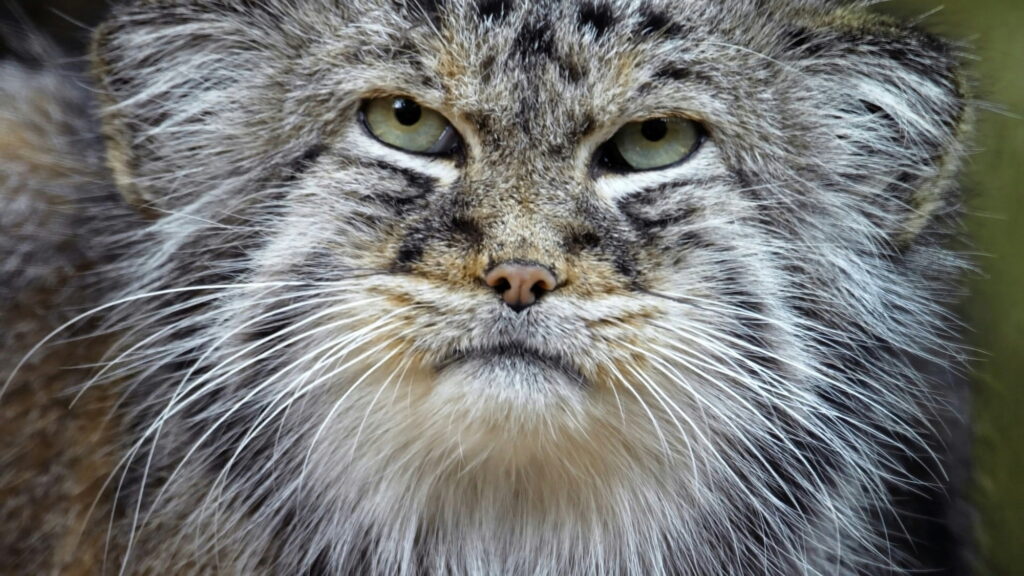
Essential Photography Gear
- Telephoto lenses: 400–600mm is ideal for capturing Manuls without disturbing them.
- Tripods and monopods: Lightweight yet stable, essential for early morning or dusk photography when light is low.
- Camera traps: Useful for capturing nocturnal activity or elusive individuals.
- Protective gear: Dust covers, lens hoods, and rain protection are necessary for desert and mountain conditions.
- Extra batteries and memory cards: Cold temperatures drain batteries faster, and long waits require multiple memory options.
Field Techniques
- Patience: Manuls can remain motionless for hours; patience is essential.
- Camouflage: Wear muted clothing and use natural covers to avoid detection.
- Positioning: Early morning and late afternoon offer the best lighting and activity windows.
- Observation points: Rocky outcrops, ridgelines, and burrow entrances are ideal locations to set up equipment.
Ethical Practices
- Respect habitat: Avoid disturbing dens, burrows, or feeding sites.
- Distance: Maintain a minimum distance to prevent stress or behavioral changes.
- No baiting: Feeding or luring Manuls is discouraged as it disrupts natural behavior.
- Conservation support: Consider contributing to local research or wildlife protection initiatives.
Anecdotes from Previous Expeditions
Explorer.Company clients frequently describe the thrill of spotting a Manul against the backdrop of a snow-dusted Altai ridge or perched atop a sun-warmed rock in the Gobi Desert. Many photographers recount waiting silently for hours, only to capture fleeting glimpses of the cat—a tail flick, a head peek, or a stalking pounce. These moments are rare but unforgettable, highlighting the rewards of careful planning, patience, and knowledge of the species.
Conservation: Protecting the Manul
Despite its adaptations, the Manul faces multiple threats in the wild. Conservation efforts in Mongolia aim to ensure the survival of this elusive cat and its fragile ecosystem.
Threats
- Habitat Loss: Grazing expansion, mining, and infrastructure development fragment Manul habitats.
- Prey Decline: Pesticides and poisoning campaigns targeting rodents reduce food availability.
- Predation and Human Disturbance: Domestic dogs and human encroachment create additional pressure.
- Climate Change: Altered precipitation and temperature patterns impact prey populations and den availability.
Current Conservation Efforts
- Research Projects: Camera traps, GPS tracking, and ecological studies help estimate populations and understand movement patterns.
- NGO Programs: Local organizations collaborate with communities to reduce conflict, protect habitats, and educate herders about wildlife.
- Ecotourism Support: Expeditions organized by Explorer.Company fund research and incentivize conservation through responsible tourism.
- Community Engagement: Educating local populations on the ecological role of Manuls fosters coexistence and sustainable land use practices.
Why Conservation Matters
Manuls are indicators of ecosystem health. Their presence signals a robust prey population and minimal human disturbance. Protecting them ensures the survival of other species, maintains biodiversity, and preserves Mongolia’s wild landscapes for future generations.
Practical Travel Guide
Traveling to see the Manul requires preparation, knowledge, and respect for Mongolia’s remote and often harsh environment.
Best Time to Visit
- Spring (April–May): Increased activity following winter; optimal for sightings.
- Summer (June–August): Longer days allow for extended observation; higher temperatures require careful planning.
- Autumn (September–October): Cooler temperatures and more active hunting make sightings more predictable.
- Winter (November–February): Harsh conditions offer unique photographic opportunities but require specialized gear and experience.
Packing List
Clothing:
- Layered clothing for temperatures ranging from –30°C to +30°C
- Insulated jackets, thermal underwear, gloves, and hats
- Waterproof outer layers for rain and snow
Camping Gear:
- Sleeping bags rated for extreme cold
- Lightweight tents or rooftop tents provided by AVIS Mongolia
- Portable stoves and cooking equipment
Photography Gear:
- Telephoto lenses (400–600mm)
- Tripods, monopods, and camouflage covers
- Extra batteries, chargers, and memory cards
Navigation and Safety:
- GPS devices, offline maps, compass
- Satellite communicator or phone with coverage in remote areas
- First aid kit and recovery equipment for off-road travel
Permits and Logistics
- National park permits required in protected areas
- Explorer.Company handles all permits for guided tours
- Self-drive travelers must plan fuel, water, and food supplies for remote locations
Safety Considerations
- Extreme weather can change rapidly; always monitor conditions
- Avoid traveling alone in remote regions
- Respect wildlife and maintain safe distances
Beyond the Manul: Combining Adventures
While Manul watching is the primary focus, Mongolia offers a rich tapestry of wildlife, landscapes, and culture. Combining your expedition with other activities enhances the overall experience:
- Snow Leopard Expeditions: Focused trips in the Altai Mountains or Gobi Desert
- Wild Horse Observation: Przewalski’s horses in Khustain Nuruu
- Eagle Hunter Experiences: Kazakh eagle hunting in Bayan-Ölgii Province
- Horseback Riding: Across the steppes, offering unique perspectives on Manul habitat
- Fishing & Camping: In rivers and lakes of Western Mongolia
Explorer.Company can integrate these adventures into a single customized itinerary, ensuring a holistic experience that blends wildlife observation, cultural immersion, and adventure travel.
Conclusion: The Magic of Meeting a Manul
Encountering a Manul in the wild is an unforgettable experience, a moment that connects you with the untamed heart of Mongolia. Observing its flattened face peek from a rocky outcrop, witnessing its stealthy pounce on unsuspecting prey, and following its tracks across snow-dusted steppes offers a glimpse into a world largely untouched by human influence.
With Explorer.Company’s expertise in adventure travel and wildlife guiding, coupled with AVIS Mongolia’s rugged 4×4 rental vehicles, travelers gain access to Mongolia’s most remote and pristine Manul habitats. Whether through guided Mongolia expeditions or Mongolia self-drive adventures, careful planning and respect for wildlife ensure not only personal enrichment but also the continued survival of this extraordinary species.
For photographers, wildlife enthusiasts, and adventurous travelers alike, the Manul is more than a cat—it is a symbol of Mongolia itself: wild, mysterious, enduring, and profoundly inspiring. With patience, preparation, and the right guidance, a journey to see the Manul can be the adventure of a lifetime.

